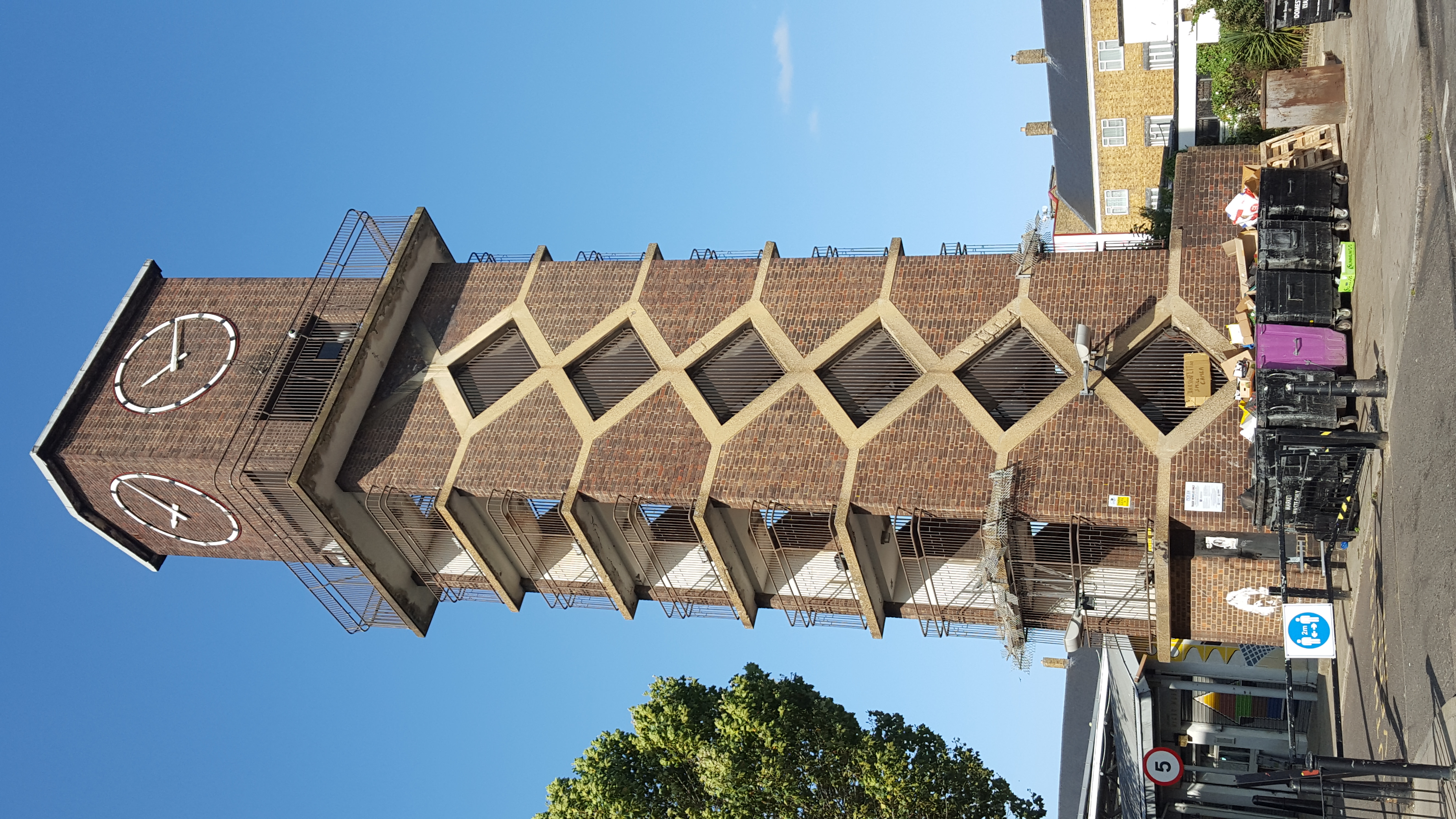|
Chrisp Street Market Clock Tower
Chrisp Street Market Clock Tower is a Grade II listed landmark located in Market Square, Chrisp Street, Poplar. It was designed by the architect Frederick Gibberd as part of the Lansbury Estate for the Festival of Britain, 1951. The clock tower is an example of early post-war architecture, and an aesthetic that became known as the "Festival Style". History The clock tower was designed in 1949 by Frederick Gibberd as part of his plans for Chrisp Street Market Chrisp Street Market is the central marketplace and town centre of Poplar and is located in the London Borough of Tower Hamlets. It was the first purpose-built pedestrian shopping area in the United Kingdom, rebuilt as part of the 1951 Festiva ..., a pedestrianised shopping area that would form the commercial centre of the new Lansbury Estate. The estate was a landmark project in post-war urban renewal, and formed part of the Live Architecture Exhibition at the Festival of Britain, 1951. However budgetary cuts and ... [...More Info...] [...Related Items...] OR: [Wikipedia] [Google] [Baidu] |
Clock Tower At Chrisp Street Market E14 6LP
A clock or a timepiece is a device used to measure and indicate time. The clock is one of the oldest human inventions, meeting the need to measure intervals of time shorter than the natural units such as the day, the lunar month and the year. Devices operating on several physical processes have been used over the millennia. Some predecessors to the modern clock may be considered as "clocks" that are based on movement in nature: A sundial shows the time by displaying the position of a shadow on a flat surface. There is a range of duration timers, a well-known example being the hourglass. Water clocks, along with the sundials, are possibly the oldest time-measuring instruments. A major advance occurred with the invention of the verge escapement, which made possible the first mechanical clocks around 1300 in Europe, which kept time with oscillating timekeepers like balance wheels., pp. 103–104., p. 31. Traditionally, in horology, the term ''clock'' was used for a st ... [...More Info...] [...Related Items...] OR: [Wikipedia] [Google] [Baidu] |
Grade II Listed
In the United Kingdom, a listed building or listed structure is one that has been placed on one of the four statutory lists maintained by Historic England in England, Historic Environment Scotland in Scotland, in Wales, and the Northern Ireland Environment Agency in Northern Ireland. The term has also been used in the Republic of Ireland, where buildings are protected under the Planning and Development Act 2000. The statutory term in Ireland is " protected structure". A listed building may not be demolished, extended, or altered without special permission from the local planning authority, which typically consults the relevant central government agency, particularly for significant alterations to the more notable listed buildings. In England and Wales, a national amenity society must be notified of any work to a listed building which involves any element of demolition. Exemption from secular listed building control is provided for some buildings in current use for worship, ... [...More Info...] [...Related Items...] OR: [Wikipedia] [Google] [Baidu] |
Poplar, London
Poplar is a district in East London, England, the administrative centre of the London Borough of Tower Hamlets, borough of Tower Hamlets. Five miles (8 km) east of Charing Cross, it is part of the East End of London, East End. It is identified as a major district centre in the London Plan, with its district centre being Chrisp Street Market, a significant commercial and retail centre surrounded by extensive residential development. Poplar includes Poplar Baths, Blackwall Yard and Trinity Buoy Wharf and the locality of Blackwall, London, Blackwall. Originally part of the Stepney#Manor and Ancient Parish, Manor and Ancient Parish of Stepney, the ''Hamlet of Poplar'' had become an autonomous area of Stepney by the 17th century, and an independent parish in 1817. The Hamlet and Parish of Poplar included Blackwall, London, Blackwall and the Isle of Dogs. After a series of mergers, Poplar became part of the London Borough of Tower Hamlets in 1965. History Origin and administrati ... [...More Info...] [...Related Items...] OR: [Wikipedia] [Google] [Baidu] |
Frederick Gibberd
Sir Frederick Ernest Gibberd (7 January 1908 – 9 January 1984) was an English architect, town planner and landscape designer. He is particularly known for his work in Harlow, Essex, and for the BISF house, a design for a prefabricated council house that was widely adopted in post-war Britain. Biography Gibberd was born in Coventry, the eldest of the five children of a local tailor, and was educated at the city's King Henry VIII School. In 1925 he was articled to a firm of architects in Birmingham and studied architecture under William Bidlake at the Birmingham School of Art, where his roommate was F. R. S. Yorke. A good friend of Sir Geoffrey Jellicoe, Gibberd's work was influenced by Le Corbusier, Mies van der Rohe, and F. R. S. Yorke. He set up in practice in 1930, designing Pullman Court, Streatham Hill, London (1934–36), a housing development which launched his career. With the success of this scheme, Gibberd became established as the 'flat' architect and went on to ... [...More Info...] [...Related Items...] OR: [Wikipedia] [Google] [Baidu] |
Lansbury Estate
The Lansbury Estate is a large, historic council housing estate in Poplar and Bromley-by-Bow in the London Borough of Tower Hamlets. It is named after George Lansbury, a Poplar councillor and Labour Party MP. History Lansbury Estate is one of the largest such estates in London. It occupies an area bounded by the East India Dock Road to the south, the Docklands Light Railway to the east and the Limehouse Cut canal to the north-west. Layout of the estate, built on a site badly damaged by bombing during the Second World War, began in 1949 to a design by London County Council planners led by Arthur Ling and Percy Johnson-Marshall. Construction of the estate started shortly before 1951 as the Live Architecture Exhibition for the Festival of Britain, with Frederick Gibberd's Chrisp Street Market area and the Trinity Independent Chapel. The construction of the housing and other land-uses extended westwards, with the final phase, at Pigott Street, finished in 1982, near Bartlett ... [...More Info...] [...Related Items...] OR: [Wikipedia] [Google] [Baidu] |
Festival Of Britain
The Festival of Britain was a national exhibition and fair that reached millions of visitors throughout the United Kingdom in the summer of 1951. Historian Kenneth O. Morgan says the Festival was a "triumphant success" during which people: Labour cabinet member Herbert Morrison was the prime mover; in 1947 he started with the original plan to celebrate the centennial of the Great Exhibition of 1851. However, it was not to be another World Fair, for international themes were absent, as was the British Commonwealth. Instead the 1951 festival focused entirely on Britain and its achievements; it was funded chiefly by the government, with a budget of £12 million. The Labour government was losing support and so the implicit goal of the festival was to give the people a feeling of successful recovery from the war's devastation, as well as promoting British science, technology, industrial design, architecture and the arts. The Festival's centrepiece was in London on the South Bank ... [...More Info...] [...Related Items...] OR: [Wikipedia] [Google] [Baidu] |
Chrisp Street Market
Chrisp Street Market is the central marketplace and town centre of Poplar and is located in the London Borough of Tower Hamlets. It was the first purpose-built pedestrian shopping area in the United Kingdom, rebuilt as part of the 1951 Festival of Britain and is directly connected onto the high street, East India Dock Road. It features a prominent clock tower, shops, small retail outlets, pubs, cafes, flats, and 80 market stalls. History Chrisp Street Market was designed by Frederick Gibberd, and built as part of the Festival of Britain in 1951. Since 1997 it has been in a conservation area. In the 1990s, the London Docklands Development Corporation contributed £1.3 million to refurbishment of the market area. In the early 2000s, Chrisp St Library was closed and replaced with a larger 'Idea Store' designed by David Adjaye, a place for lifelong learning with computers and rooms for community use. The Tower Hamlets London Borough Council transferred ownership of the s ... [...More Info...] [...Related Items...] OR: [Wikipedia] [Google] [Baidu] |
Clock Towers In The United Kingdom
A clock or a timepiece is a device used to measure and indicate time. The clock is one of the oldest human inventions, meeting the need to measure intervals of time shorter than the natural units such as the day, the lunar month and the year. Devices operating on several physical processes have been used over the millennia. Some predecessors to the modern clock may be considered as "clocks" that are based on movement in nature: A sundial shows the time by displaying the position of a shadow on a flat surface. There is a range of duration timers, a well-known example being the hourglass. Water clocks, along with the sundials, are possibly the oldest time-measuring instruments. A major advance occurred with the invention of the verge escapement, which made possible the first mechanical clocks around 1300 in Europe, which kept time with oscillating timekeepers like balance wheels., pp. 103–104., p. 31. Traditionally, in horology, the term ''clock'' was used for a striki ... [...More Info...] [...Related Items...] OR: [Wikipedia] [Google] [Baidu] |
Grade II Listed Buildings In The London Borough Of Tower Hamlets
Grade most commonly refers to: * Grade (education), a measurement of a student's performance * Grade, the number of the year a student has reached in a given educational stage * Grade (slope), the steepness of a slope Grade or grading may also refer to: Music * Grade (music), a formally assessed level of profiency in a musical instrument * Grade (band), punk rock band * Grades (producer), British electronic dance music producer and DJ Science and technology Biology and medicine * Grading (tumors), a measure of the aggressiveness of a tumor in medicine * The Grading of Recommendations Assessment, Development and Evaluation (GRADE) approach * Evolutionary grade, a paraphyletic group of organisms Geology * Graded bedding, a description of the variation in grain size through a bed in a sedimentary rock * Metamorphic grade, an indicatation of the degree of metamorphism of rocks * Ore grade, a measure that describes the concentration of a valuable natural material in the surrounding ... [...More Info...] [...Related Items...] OR: [Wikipedia] [Google] [Baidu] |





.jpg)

